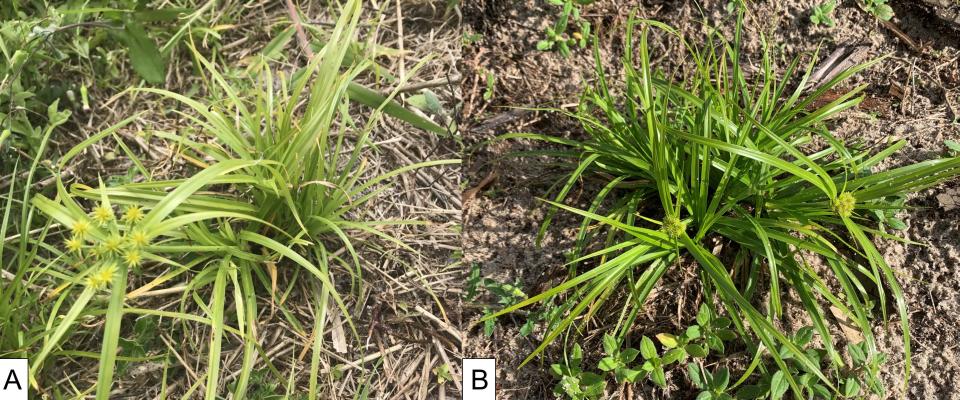Plant Health Alert! This Harmful Bacteria Is a First for North America

In field samples taken by scientists in Ft. Pierce, FL, these examples show yellow nutsedge weeds infected with Candidatus Phytoplasma brasiliense (A) vs. a non-infected specimen (B).
Photo by Brian Bahder
University of Florida scientists report they have recently recorded the first North American case of a harmful phytoplasma disease, Candidatus Phytoplasma brasiliense, which is known as a threat to fruit, vegetable, and ornamental crops in South America and the Middle East. And to make matters worse, they confirmed the host for the disease to be one of the most noxious weeds commonly found in a wide range of environments throughout the U.S. and Canada.
“The host of the disease (yellow nutsedge) is known as one of the most widespread and problematic weeds found everywhere,” says Brian Bahder, Assistant Professor of entomology at UF/IFAS Fort Lauderdale Research and Education Center. “It is one of the most aggressive weeds that commonly grows in lawns, home landscapes, vegetable and flower gardens, and agricultural systems.”
The phytoplasma species called Candidatus Phytoplasma brasiliense has been documented in regions of Brazil and Peru to harm hibiscus, papaya, and cauliflower. Subsequently, research showed the same species infects peaches in Azerbaijan.
Bahder and his team confirmed the phytoplasma and host in Ft. Pierce, FL. They found it while conducting research for a different disease that attacks palm trees – lethal bronzing.
Research has shown the adult planthopper insect that carries lethal bronzing feeds on the palm’s canopy, and the nymphs have been recorded among more than 40 species of grasses and sedges. Because of the close association of nymphs with grasses and sedges, speculation has risen about the ability of these plants to serve as a reservoir for the lethal bronzing phytoplasma, according to Bahder.
For the survey, scientists sampled three of the most abundant weeds known to serve as a host to the nymphs, yellow nutsedge being one of them. While testing the samples, three of the outcomes resulted in a positive result.
The DNA sequencing of that specimen confirmed their findings of a new phytoplasma in this weed, recorded for the first time in North America.
Implications of the disease and its spread through this weed cause scientists to consider it a threat to agriculture and ornamental industries. UF/IFAS scientists are seeking funding for the next steps of research.
“The next logical step is to find out which insect is spreading the disease,” Bahder adds. “The good news is that we caught this early. We don’t know if this is an isolated incident or if the insect is spreading in the grass, and if it will feed on the papaya, hibiscus, or cauliflower – which are economically important in Florida. The point is that we don’t know the extent of this disease in Florida or what threat it poses.
For more info, findings of the “First report of ‘Cadidatus Phytoplasma brasiliense’ in North America and in a new host, yellow nutsedge (Cyperus esculentus)” were recently published in the journal Plant Health Progress.









